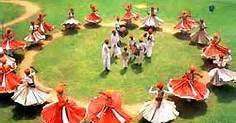Punjab, a land of fantastic folklores and cultural extravaganzas is
also not for its colorful and energetic dance forms. Contrary to popular belief, Bhangra and Gidda are not the only Punjabi dances. The hallmark of gaiety, Jhumar is another popular dance form of the state.
Originating from Pakistan's Sandalbar, the elegant Jhumar dance is an integral part of the quintessential Punjabi folk culture. The drummer is seated in the center and encircled by dancers who encircle him and dance gaily singing the merry tunes.
The Jhumar dance is a tribute to human happiness. It is performed exclusively by the local men folk during fairs, weddings and other major festivals and celebrations. It is a wonderful experience to see three generations -grandfather, father and son sway together to the Jhumar beats. Jhumar is composed of three predominant moods to suit different occasions and is hence suitable for all joyous celebrations.
The dancers dress in colorful, gaudy costumes resembling the Bhangra wear and sway to and fro to the lilt of soul stirring and
emotional tunes. Devoid of complex acrobatic, it is merely a movement of arms with slight feet movements and a few twists and turns.
This highly popular dance, performed on beautiful moonlit nights under the open sky has been fused with the Bhangra. As the dancers move the make a soft "dee-dee" hum to enhance the beauty and appeal of this highly alluring dance.
Danced by all generations of Punjabi men folk together, Jhumar is a popular dance that is enormously enjoyed by the young and old, rich and poor, men and women and locals and tourists alike.
Thanks,
Surbhi Maheshwari [MBA Fin / Mktg ]
Manager Finance
On Line Assistence :
Gtalk : SurbhiM.AeroSoft@gmail.com



















+Stadium,+Ludhiana.jpg)

.jpg)






















